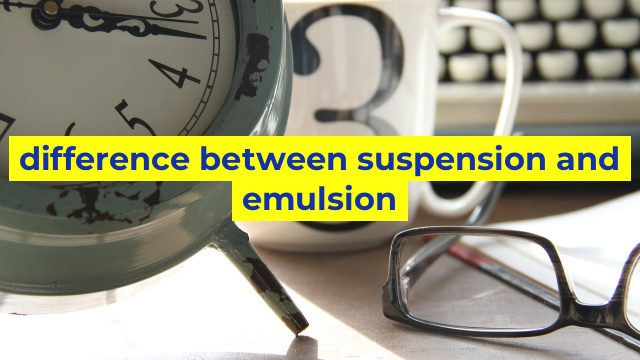The Difference Between Suspension and Emulsion
When it comes to pharmaceuticals, cosmetics, and food, we often come across the terms “suspension” and “emulsion”. These terms refer to different types of formulations that are used to deliver active ingredients to the body. Although both suspension and emulsion are used to mix two or more substances, they differ in their composition, properties, and applications. Let’s examine the difference between suspension and emulsion.
Suspension
A suspension is a formulation in which solid particles are suspended in a liquid medium. In other words, it is a heterogeneous mixture where the dispersed particles do not dissolve but remain suspended in the liquid due to their size and weight. Suspensions are often used for administering drugs that are poorly water-soluble and need to be delivered in a liquid form. For example, antibiotic suspensions are commonly used to treat bacterial infections in children, as they are easier to swallow than tablets.
The properties of a suspension depend on the size, shape, and concentration of the particles. In general, the larger the particle size, the more noticeable the settling of the mixture. Therefore, suspensions need to be well-shaken before administration to ensure uniform distribution of particles. The particle size can also affect the rate of absorption and the onset of action of the active ingredient.
Emulsion
An emulsion is a mixture of two immiscible liquids, such as oil and water, stabilized by an emulsifying agent. Emulsions can be either oil-in-water (O/W) or water-in-oil (W/O), depending on the phase that is dispersed and the phase that is continuous. Emulsions are used in cosmetics and personal care products, as well as in food and beverage industry, to improve the taste, texture, and appearance of products.
The stability of an emulsion depends on the nature and concentration of the emulsifying agent, as well as the droplet size of the dispersed phase. Emulsions can be thick or thin, and may have different rheological properties depending on the application. For example, a lotion for dry skin needs to have a higher oil content and a thicker consistency, while a serum for oily skin needs to have a lower oil content and a lighter texture.
Conclusion
In summary, the difference between suspension and emulsion lies in their composition and properties. While suspensions are a mixture of solid particles in a liquid medium, emulsions are a mixture of two immiscible liquids stabilized by an emulsifying agent. Suspensions are used for delivering water-insoluble drugs, while emulsions are used for improving the sensory qualities of products. Understanding the differences between these formulations is important for selecting the appropriate dosage form and ensuring product quality.
Table difference between suspension and emulsion
| Suspension | Emulsion |
|---|---|
| It is a type of mixture in which the solid particles are dispersed in a liquid. | It is a type of mixture in which two immiscible liquids are dispersed in each other with the help of an emulsifying agent. |
| The solid particles settle down at the bottom of the container when left undisturbed. | The emulsified liquids do not separate easily. |
| Examples of suspensions include sand in water or flour in water. | Examples of emulsions include milk, mayonnaise or vinaigrette. |
| Suspensions have larger particle size than emulsions. | Emulsions have smaller particle size than suspensions. |
| Suspensions are unstable and need to be stirred before use. | Emulsions are stable and do not need to be stirred before use. |

